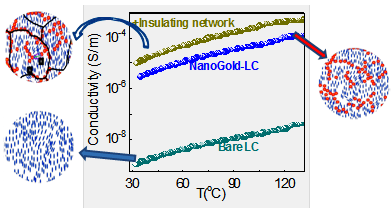Insulating network enhances electrical conductivity
B. Kamaliya, M. Vijay Kumar, C.V. Yelamaggad and S. Krishna Prasad, Appl. Phys. Lett. 106, 083110 (2015)
Liquid crystals (LCs), by nature, are insulators. Imbibing Gold nanoparticles (GNPs) into LCs, is one possible route to increase their electrical conductivity. Here we have used such a composite of nematic LC +GNP as the base system having conductivity higher than the host LC. The novel feature of this work is the imposition of a fragile thixotropic network made of insulating aerosil particles on the composite. This feature surprisingly enhances the already high conductivity of the LC-GNP material. The presence of aerosil also makes the frequency dependence of the conductivity compatible with the universal phenomenon expected for disordered solids despite the LC confined in the network is still a liquid. The nature of the aerosil corona (hydrophobic/hydrophilic) also controls the behavior. We argue that these features are caused by the amelioration of the percolation network of GNPs through the primary gel network of the hydrogen bonding aerosil particles. The concept can be generalized for a variety of systems wherein metal nanoparticles are embedded in an insulating matrix.
Posted by S. Krishna Prasad

